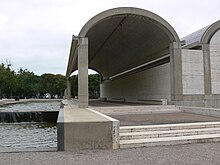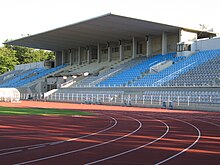August Komendant
August Eduard Komendant (born October 2, 1906 in Mäo , Estonia Governorate , † September 14, 1992 in Montclair , New Jersey ) was an American civil engineer , structural engineer and university professor. A native Este studied in Dresden, emigrated after the Second World War in the United States , where he became known as a pioneer of the use of prestressing steel in structural engineering . He worked with the successful architect Louis I. Kahn on various architecturally significant structures, two of which received the prestigious Twenty-five Year Award from the American Institute of Architects .
Life

From 1929 to 1933/34 Komendant studied civil engineering at the Technical University of Dresden . He then returned to Estonia, where he worked in the field of reinforced concrete at the Tallinn University of Technology and was responsible for various structures, including the stands of the Kadrioru stadium in Tallinn , a granary in Tartu and an aircraft hangar.
After Germany occupied Estonia in World War II, Komendant was brought to Germany to work on war projects. In the final stages of the war he was interned by the US Army and hired by General George Patton to work for him in restoring bridges. Even after the war he stayed with the US Army to rebuild bridges.
In 1950 Komendant emigrated to the USA and opened an engineering office in Upper Montclair, New Jersey. Because of his experience with pre-stressed concrete in the restoration of bridges he published in 1952 Prestressed Concrete Structures (about: structures made of reinforced concrete ), which made him an authority in this field. Komendant liked to explain the function of prestressed concrete with the demonstration that you can lift a row of books in the air if you press them together so hard that they behave like a single solid element.
In 1957 he met the architect Louis I. Kahn , who was almost the same age and also from Estonia . This marked the beginning of an extremely fruitful collaboration between architect and structural engineer, often accompanied by a dispute between the different characters. During the time when Louis I. Kahn became one of the most famous architects in the USA, August Komendant played a key role in many of his buildings as a structural engineer. The relationship was not ended until Kahn's death 18 years later. Their first joint project was the building of the University of Pennsylvania's Richards Medical Research Laboratories in Philadelphia , Pennsylvania . This was followed by the Jatiya Sangsad Bhaban ( House of the National Assembly ) in Dhaka , Bangladesh , the First Unitarian Church of Rochester in Rochester (New York) , the Salk Institute for Biological Studies in La Jolla , San Diego , California , and the Olivetti-Underwood Factory in Harrisburg, Pennsylvania and the Kimbell Art Museum in Fort Worth , Texas . Two of these joint projects, the Salk Institute and the Kimbell Art Museum, received the American Institute of Architects' Twenty-five Year Award .
August Komendant was Professor of Architecture at the University of Pennsylvania from 1959 to 1974 (at which Kahn also taught from 1957 to 1974) and in the late 1970s was Visiting Professor at the Pratt Institute in New York City . He received the Allied Professions Medal from the American Institute of Architects in 1978.
Private
August E. Komendant was married to Helmi (nee Aren, 1906-2006) and had two children, daughter Merike and son Juri.
Fonts (selection)
- Prestressed Concrete Structures , McGraw-Hill, New York 1952
- Contemporary Concrete Structures , McGraw-Hill, New York 1972, ISBN 007035328X
- 18 years with Architect Louis I. Kahn , Aloray, Englewood, NJ 1975, ISBN 9780913690062
- Practical Structural Analysis for Architectural Engineering , Prentice-Hall, Englewood Cliffs, New Jersey 1987, ISBN 9780136939610
Web links
- On the 100th birthday of August Komendant on Eesti Päevaleht (Estonian), accessed on 23 August 2011
- August E. Komendant , entry on Penn University website, accessed August 23, 2011
- Thomas Leslie: “Unavoidable Nuisances”: August Komendant, Louis I. Kahn, and the Difficult Relationship between Building Design and Engineering on Estonian Architectural Review, accessed on 23 August 2011
Individual evidence
- ↑ The article is based on the web links and on the article in the English Wikipedia
- ^ The Washington Post, September 21, 1992, Monday, Final Edition, METRO, p. 84, OBITUARIES
- ↑ There is no evidence of a doctorate in engineering in Dresden.
- ^ AE Komendant, 85, A Structural Engineer . New York Times, Sept. 18, 1992, p. A26
| personal data | |
|---|---|
| SURNAME | Komendant, August |
| ALTERNATIVE NAMES | Comendant, August Eduard |
| BRIEF DESCRIPTION | American civil engineer, structural engineer and university professor |
| DATE OF BIRTH | October 2, 1906 |
| PLACE OF BIRTH | Maeo , Estonia Governorate |
| DATE OF DEATH | September 14, 1992 |
| Place of death | Montclair , New Jersey |
